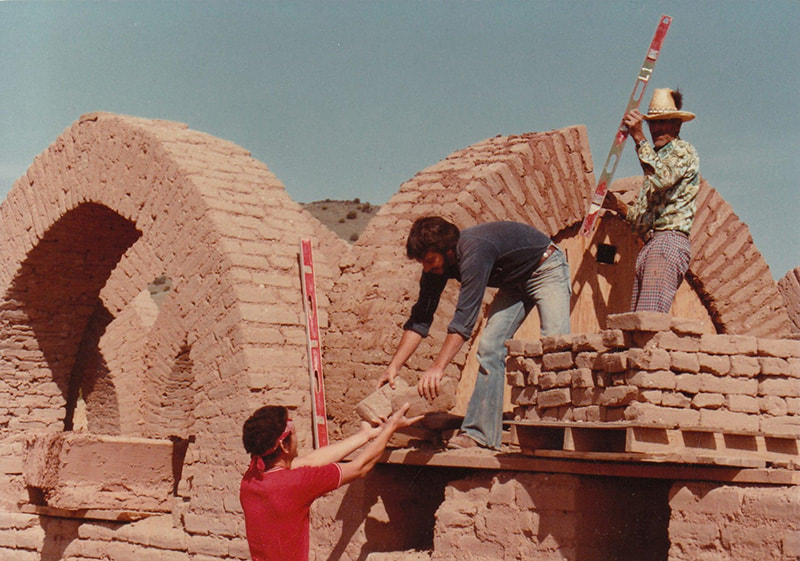|
By Karima Alavi
Visitors to Dar al Islam, the site of a mosque and madressah (retreat and educational facility) often ask “why?” Why this place? Next, comes the question of “How?” How was this structure, reflecting the architectural traditions of North Africa, built? What’s the story behind this place that sits upon a mesa overlooking the Chama River and the Pueblo of Abiquiu on one side, and White City, or Plaza Blanca, on the other side? The answers to those questions are complex and intriguing. The stories behind the non-profit foundation are many—some true, some languishing in the realm of rumors. Equally interesting are the stories of the people behind this massive project that began in 1979, its seeds being planted by a seemingly chance encounter between two men standing next to each other one hot, sunny day at the Ka’ba, a stone building at the center of Islam’s most important holy site, the mosque in Makkah, Saudi Arabia. It is in the direction of this place that Muslims around the world send their prayers. Due to the cycle of five prayers per day, all set by the movement of the sun across the planet, there is never a moment when millions of prayers are not being directed toward the sacred mosque in Makkah. Imagine the five unending prayer-rings that constantly circle the world as some people offer their morning prayers, others do afternoon or evening prayers, all depending upon the sun’s position at that moment in that part of the world. It was there, at the Ka’ba, that the two men, Nooruddeen Durkee of America and Sahil Kabbani of Saudi Arabia, began their casual conversation. One thing would lead to another and pieces of a puzzle from across many lands would fall into place as though this was not a chance encounter at all, but more a part of a divine plan, an opening to those in search of a spiritual path that called them to leave behind the religious practices they grew up with, and find something that spoke to their hearts in a new way. In our forthcoming Abiquiu News articles, Dar al Islam will recount the history of how the site was selected and how it was built with the help of American Muslim craftsmen working alongside master masons from Egypt. You can add to that list, workers from the pueblos of Taos and Abiquiu as well as surrounding communities, all supported by the efforts of women who worked behind the scenes to enable this massive undertaking to continue. We’ll also discuss the early links to Lama Foundation and the author, Ram Das, before moving on to subjects like the elementary school that once caused the halls of Dar al Islam to echo with the laughter of children, a sound that returns today during Islamic holiday celebrations and other programs, including retreats. Watch for articles about the many-faceted events hosted by Dar al Islam for both Muslims and non-Muslims alike, such as the Teachers’ Institute, or outreach to educational organizations including the National Council for the Social Studies, the World History Association, and the Library of Congress. Did you know that the Abiquiu Inn, when owned by Dar al Islam, had a laundromat on site? Are you aware of the many movies shot against the background of the local beauty and grandeur of Dar al Islam’s land? Let’s explore the people who helped create this world-famous facility as we wander through Dar al Islam’s past, their present, and their Master Plans for the future. If you, or someone you know, helped with the construction, please feel free to make a comment below. We would love to hear from you.
6 Comments
Daria Roithmayr
2/7/2025 10:19:35 am
Can't wait to read this series!
Reply
Karima Alavi
2/12/2025 12:07:14 am
Thank you, Daria.
Reply
Lynn Anderson
2/14/2025 03:57:32 pm
I worked on the Mosgue as a volunteer along with my partner Doug ECKBERG . We were there plastering and slinging mud , when the Grand Domes were being constructed . I was probably 29 30 years old at the time . Doug and I were , at that time , (care taking )the Plaza Blanca Ranch , which we did for 5 years . Many years later, S. McLain bought the Ranch . So we would go up to the construction of the Mosque
Reply
Karima Alavi
2/15/2025 07:26:45 am
Thank you for these comments, Lynn. And thank you for helping! I'm discovering that there are many, many interesting stories about those early days of construction. If you're still in northern NM, feel free to stop by and see the place. One of my future articles will be about the workshop on domes and arches that was offered by Hassan Fathy and the Egyptian master masons. I'm glad you were able to learn from them.
Reply
Tom Minor
2/14/2025 10:48:36 pm
I was working as an architectural intern for Bill
Reply
Karima Alavi
2/15/2025 07:31:17 am
Thank you for this information, Tom. It was my husband, Walter Declerck, who sought the "stamp of approval" from Bill Lumpkin, a man with quite an architectural legacy in this region. Few people are aware of his involvement with the mosque at Dar al Islam. I've been planning to mention him in the article about the very early stages of construction. I'm glad you could be a part of it.
Reply
Your comment will be posted after it is approved.
Leave a Reply. |
Submit your ideas for local feature articles
Profiles Gardening Recipes Observations Birding Essays Hiking AuthorsYou! Archives
October 2025
Categories
All
|

 RSS Feed
RSS Feed